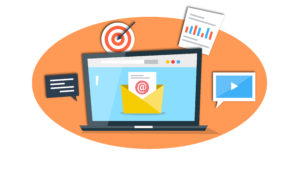01
Starting a Successful Email Campaign
 We all know the feeling of waking up to a full inbox. In a matter of seconds we decide what’s important and what isn’t, what to read now or save for later, and what to delete without thinking twice. As a person living in a high-speed and often overly stimulating world of technology, this is just part of keeping your inbox in check. As a business, however, it’s important to think about how to differentiate the emails you send from the rest so that they don’t get automatically lumped into the delete pile.
We all know the feeling of waking up to a full inbox. In a matter of seconds we decide what’s important and what isn’t, what to read now or save for later, and what to delete without thinking twice. As a person living in a high-speed and often overly stimulating world of technology, this is just part of keeping your inbox in check. As a business, however, it’s important to think about how to differentiate the emails you send from the rest so that they don’t get automatically lumped into the delete pile.
If you’re not sure how to get started, here are six steps you can take to run a successful email marketing campaign:
- Have a Clear Objective: Why are you sending the email? Are you looking to get patients to participate in a contest? Are you providing them with valuable information? Are you just trying to create brand awareness? Always have a clear goal to keep you on track. This way, you can check in at multiple stages of the process (imagery, layout, wording etc.) and ask yourself if everything works together to meet your goal.
- Choose the Subject Line Wisely: The first impression people will have of your email before they even open it will come from the subject line. Don’t try to get too fancy or too punny here, it’s much better to be clear and concise and let your readers know what they can expect to find in your email. You can also appeal to their sense of curiosity with a subject line like, “Five Dental Health Trends to Avoid This Year.” You’re telling them what the email is about, while still giving them an incentive to open it.
- Craft the Copy: Congrats! You’ve gotten the reader to click on your subject line. Now what? The rest of your email is just as important as the subject line. Make your tone conversational, as if you were talking to a friend. For best results, keep the body of the email short and sweet. You don’t want to overwhelm your reader or risk losing their attention. If you have a lot of information to share, make sure you choose a template that gives you a button of some sort so you can link to the longer version of your email elsewhere.
- CTAs and Links: Speaking of templates with buttons, make sure every email you send has a call to action (CTA) of some sort. Buttons are great way to do this. If you’re running a contest you’d like them to enter it might say “Enter Here!”, if you’re linking to a long form article it could say, “Read More!” Whatever it is, your CTA should encourage your reader to continue to engage with your content. You’ll also want to make sure that your social networks are linked in your email to increase awareness of your social media presence.
- Select the Right Design: Unless you’re building your own email from scratch, you will likely be using a template of some sort. Make sure the template you select is easy to read and optimized for both desktop and mobile devices. If you’re including photos (hint: you should) make sure they are properly sized and placed strategically throughout the email so they split up your text.
- Test it Out: The best way to figure out what works best for your particular audience is by testing what you’ve got. Before you send out an email to your entire list, consider taking 100 people (or however many is appropriate for your list) and splitting them into two groups of 50. The first 50 receive subject line A, for example, while the second 50 receive subject line B. This is a great way to see which of the two performs better, so when you send out the massive email you do so knowing the odds are in your favor.
Building an email marketing campaign is an effective way to grow your brand, get more engagement and build a relationship with your audience. Similar to social media, email marketing should be thoughtful and always serve a specific purpose. The most basic goal should be for the recipient to want to read your email, not be frustrated that you’re saturating their inbox. The frequency at which you send emails and the tools that you use to do so will probably determine how deep you’ll dive into analyzing data and results from your email campaigns. However, these are six great starting points if you’re new to the email campaign world. You don’t have to do them all, but even two or three will ensure your email is off to a good start!
—Michelle Hammond, Social Media Specialist, Sesame Communications
